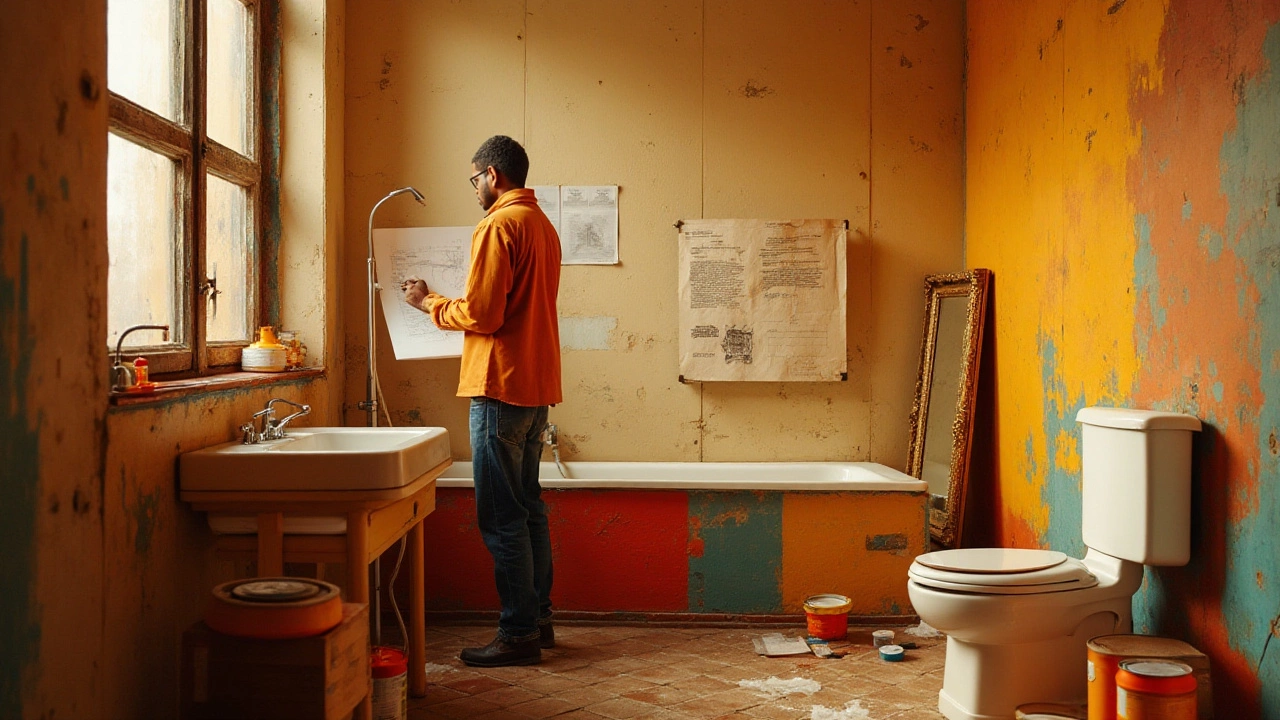Embarking on a small bathroom renovation is often as thrilling as it is daunting. Homeowners plunge into what can seem like a simple project, only to find that timelines fluctuate with each design tweak or shipping delay.
Whether you're revamping a tired-looking washroom or transforming it into a serene spa-like retreat, understanding the timeline helps in smoothing out the bumps along this road.
This article serves as a useful guide to navigate through the crucial stages of the renovation process, making sure to keep you grounded in reality. From conceptualization to the final inspection touch, dive into the heart of home improvement. Ready your toolkit of patience and precision for a small bathroom that offers big possibilities.
- Initial Planning and Design
- Demolition and Preparation
- Plumbing and Electrical Work
- Installation of Fixtures and Finishes
- Final Touches and Inspection
Initial Planning and Design
Before diving into the hands-on work of a bathroom renovation, detailed initial planning and design are mission-critical. This stage isn't just about picking tiles and color palettes but encompasses a thorough evaluation of what the current bathroom lacks and how to address these shortcomings. One of the first steps involves assessing the flow and functionality—ponder over whether the current layout makes efficient use of the available space. For instance, relocating plumbing fixtures like toilets and sinks might optimize space, but it also adds complexity and costs to the project.
The design phase is your opportunity to dream big. However, it’s crucial to set realistic boundaries in terms of budget and available space. Consider how often trends change and whether your choices will stand the test of time. Hiring a professional designer can save time and money in the long run by providing expertise in aesthetics and practical design innovations. According to a survey by the National Kitchen and Bath Association, a significant number of homeowners opt for professional designers due to their ability to blend functional solutions with aesthetic appeal.
A thorough planning phase includes creating a checklist of desired improvements and setting priorities so that must-haves are clearly distinguished from nice-to-haves. This often means long discussions with all household members to ensure everyone's needs are heard and incorporated. A mood board might be an enjoyable and tangible way to visualize the intended outcome. It assists in harmonizing color schemes and in deciding on a unified theme, whether it's modern minimalism, rustic charm, or something else entirely.
A budget is the backbone of any successful renovation project. Determining how much you're willing or able to spend can aid in decision-making and prevent unnecessary overspending. Allocate funds for unexpected costs that typically arise in any renovation project. According to Remodeling Magazine's reports, many homeowners end up spending 20% more than planned due to unforeseen structural issues or amendment requests that arise during the course of the project.
"Failing to plan is planning to fail." This age-old adage particularly resonates when it comes to home renovations, as the majority of mishaps happen during the planning phase, not execution.
Don't underestimate the logistics involved—from permits to materials delivery. For example, sourcing locally can minimize delays, but checking in advance if local suppliers have your desired tiles or fittings in stock is wise. The availability of materials can significantly alter your timeline. Based on your small bathroom tips, start with a comprehensive timeline that accounts for all preparatory and decision-making stages.
Demolition and Preparation
Stepping into the initial phase of your bathroom renovation, the demolition and preparation stage becomes the canvas-clearing for your project. It's a critical time to properly set the foundation for success, yet often underestimated in terms of its scope and complexity. Before diving in, prepare yourself mentally and physically; this phase can be surprisingly labor-intensive. Every square inch matters in a small bathroom scenario, and precision is key. What looks like a straightforward task of ripping out tiles or cabinetry can reveal hidden surprises like outdated wiring or lurking mold, each requiring time to remedy before progressing. Demolition, with all its dust and noise, heals a space back to its blank slate, allowing creativity to flourish anew.
Preparation is equally essential and involves more than simply cleaning up the rubble. First, establish a clear plan outlining all aspects of the project. Measurements must be accurate, considering everything from your tub's dimensions to the width of your doorways; an inch misjudged now can lead to headaches later. Next, evaluate what can be salvaged from your previous setup, perhaps offering a cost-efficient edge and adding character. Sometimes, this means donating or repurposing hardware or fixtures. Proper disposal of the old materials demands careful attention; enlist a local waste service that specializes in bathroom debris if needed. Set aside ample time to address these logistical aspects, minimizing hiccups as the project progresses.
The significance of hiring experienced professionals for this phase cannot be overstated. A well-versed contractor could mean the difference between a smooth job and a stressful series of missteps. Take the time to research and read reviews. It’s often said among expert remodelers,
"A good contractor will look at your bathroom like a doctor evaluating a patient, scrutinizing every nook to ensure nothing critical is overlooked."This quote serves as a reminder of the discerning eye required at this juncture. If going the DIY route, invest in proper protective gear and quality tools. Safety, above all, should be prioritized, as the use of heavy machinery and handling of potentially hazardous materials pose risks. Attention to detail now saves time and unexpected costs later, and it becomes the best gift you can offer your future self.
Logistically, planning the timing of demolition is crucial, often lasting between one to five days depending on the complexity and size of your bathroom renovation. Consult with your contractors to schedule diligently, keeping regional weather conditions and waste removal timing in mind. A detailed timeline covering each step of this stage aids in maintaining a steady progress pace. Also, factor in potential delays—be it unforeseen structural issues or simple scheduling conflicts. Patience becomes your greatest ally, allowing for flexibility while staying on track. Lastly, remember to communicate. Share the timeline with any involved parties, ensuring everyone is aligned. Once preparation wraps up, you'll be ready for the next phase, standing on the threshold of transforming visions into tangible reality.

Plumbing and Electrical Work
In the intricate tapestry of a small bathroom renovation, plumbing and electrical work play pivotal roles akin to the backbone of a project. When the demolition dust has settled and walls lie bare, these hidden, yet essential elements come into sharp focus. A symphony of pipes and wires is orchestrated behind the scenes, destined to bring water and light to your redesigned sanctuary. Professional plumbers and electricians possess the expertise necessary to navigate this maze effectively, ensuring safe and efficient installations while interpreting the complexities of modern design.
Plumbing adaptations might range from rerouting existing pipelines to accommodate a rearranged layout, to upgrading aged, inefficient systems with state-of-the-art alternatives. The strategic placement of fixtures like sinks, toilets, and bathtubs relies heavily on adept plumbing work to maintain seamless functionality. Meanwhile, tackling electrical components demands precision that marries aesthetics with utility. Decisions about lighting—whether favoring recessed LEDs or pendant fixtures—can dramatically alter the ambiance of a space.
During this phase, it's crucial to involve licensed professionals who understand the local building codes and regulations, preventing costly mistakes down the line. Trained pairs of eyes can identify potential structural challenges that might not be visible to an untrained observer. Removal of old pipes that may threaten health, such as those possibly containing lead, can only be done with certified expertise. The introduction of eco-friendly solutions, like low-flow toilets and energy-saving lights, can further enhance the renovation, providing both environmental and economic benefits.
"Attention to plumbing and electrics can make or break your renovation," says renowned interior designer Maxine Monroe. "Prioritize these under-the-surface aspects as much as the surface finishes to ensure a long-lasting and trouble-free bathroom experience."
Statistics suggest that allocating approximately 30% of your renovation budget to plumbing and electrical ventures is a prudent measure, as this ensures the smooth embodiment of form and function. This strategic investment often prevents unwelcome surprises later, such as leaks or inadequate lighting, that might necessitate costly remedial work. A comprehensive understanding of these systems also prevents future modifications, maintaining the structural integrity of your cherished modern haven.
Tips for Successful Implementation
- Plan Early: Incorporate plumbing and electrical designs in the early planning stages to avoid spatial conflicts.
- Hire Professionals: Engage certified tradespeople who are familiar with building codes and safety standards.
- Think Efficiency: Opt for energy-efficient fixtures and appliances to lower your ongoing utility bills.
- Inspect and Replace: Use renovation as an opportunity to inspect and upgrade any outdated plumbing or wiring systems.
- Future Proof: Consider your future needs and leave room for easy upgrades or changes.
Ultimately, plumbing and electrical work forms the structural foundation upon which your renovated bathroom will stand. By investing time and resources wisely in this critical phase, you're setting the stage for a successful renovation that harmoniously combines practicality with your desired visual appeal.
Installation of Fixtures and Finishes
When it comes to upgrading a small bathroom, the installation of fixtures and finishes is the phase where your vision begins to materialize. Imagine this as the decorators sweeping through the final rehearsal of a theatrical production. It's where the excitement reaches a crescendo. From setting up a sleek vanity to ensuring that vibrant tiles come together in harmony, the selection and installation of these elements contribute immensely to the ambiance and function of your revamped space.
Choosing the right fixtures involves more than just aesthetics. It's about harmonizing form and function while being mindful of space constraints. A compact vanity with integrated storage, for example, not only saves space but also enhances efficiency. When you're looking at toilets, consider those with dual-flush options, which can dramatically conserve water without compromising on performance. In an era where sustainability is key, such choices ensure your bathroom stands the test of time in design and environmental responsibility.
The installation phase also calls for a meticulous focus on finishes. Choices range from the sheen of chrome faucets to the subdued elegance of brushed nickel hardware. Here, textures and colors play a pivotal role. They contribute to the tactile and visual experience of your bathroom, providing warmth and personality. Opting for non-porous materials like quartz or granite for countertops can enhance durability while elevating the elegance quotient. Walls adorned with moisture-resistant paint also contribute to maintenance ease, a crucial aspect in humid environments.
Lighting acts as the unsung hero, breathing life into the bathroom's character. A blend of natural and artificial lighting is essential for a balanced experience. Consider wall-mounted sconces that flank the mirror for ideal task lighting, or a pendant light for an added touch of glam. A dimmer switch is a small addition that offers control over ambiance, transitioning from bright and functional to soft and relaxing at your whim.
"The details are not the details. They make the design." – Charles Eames, the quintessential designer whose words remind us how small choices create big impacts in home design.
As an illustration of careful planning, here's a simple table that shows the advantages of various tile materials:
| Tile Material | Advantages |
|---|---|
| Ceramic | Cost-effective, easy to clean, diverse designs |
| Porcelain | Highly durable, resistant to moisture, versatile |
| Natural Stone | Unique patterns, durable, adds value |
When all fixtures and finishes are in place, it's often worth inspecting every nook to ensure everything works as intended, leaving no room for second guesses. After all, your renovated small bathroom should not just be fit for function but an embodiment of comfort and character, crafted with precision and care. Each carefully executed detail in this stage lays the foundation for a space that's truly your own.

Final Touches and Inspection
The home stretch in a bathroom renovation can be both thrilling and nerve-wracking. You've navigated through the storm of demolition, plumbing intricacies, and the meticulous installation of fixtures. Now, it's time for those final touches that transform your small bathroom into a personalized oasis. It’s important to remember how crucial these last steps are in ensuring that all your hard work translates into a functional and visually pleasing space.
Small details such as the placement of accessories, the choice of towels, or the lighting fixtures can dramatically influence the ambiance. Opting for layered lighting often works wonders—the combination of ambient, task, and accent lighting brightens the space while enhancing its functionality. Mirrors, besides being practical, are also fantastic at creating an illusion of a larger area, a trick that works especially well in compact bathroom settings.
Ensuring everything is perfectly sealed and watertight cannot be stressed enough. Gaps between tiles or improperly sealed fixtures lead to moisture issues that can compromise the integrity of your renovation. This is where the silicone gun earns its keep, as well-executed sealing bars any future leaky problems. At this juncture, paint touch-ups might also be necessary, so keep an eye out for any smudges or imperfections that need attention.
Inspection and Sign-Off
Once the finishing touches are applied, it’s critical to conduct a thorough inspection. A meticulous walk-through helps uncover any minor hiccups or adjustments needed. Some might wonder why such detail is necessary, but the final inspection ensures every aspect aligns with your vision and meets high standards. Invite experts or consultants if possible to get a professional review. As Home Improvement expert Bob Vila aptly stated,
"The best tool in a renovator’s kit is a keen eye for detail."This wisdom rings true when vetting the completed work.
During this phase, don’t shy away from testing fixtures and fittings. Run the water, flush the toilet, try the power outlets—these checks ensure everything flows smoothly. It's also a great time to double-check the installation of ventilation fans, which are vital in combatting moisture accumulation. As an investment in both time and aesthetics, inspecting consistently during and after the renovation helps prevent future wear and tear.
Concluding your renovation journey involves not only completing the visual elements but also conducting a comprehensive evaluation. In doing so, you leave nothing to chance, ensuring you have a bathroom that will delight you and your guests for years to come. While it may feel like an extended effort, remember, satisfaction lies in the details. A graceful final brush and seasoned inspection lay the groundwork for a home space that marries form with functionality seamlessly.

Written by Fletcher Abernathy
View all posts by: Fletcher Abernathy